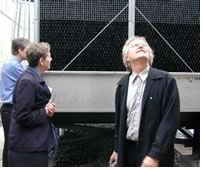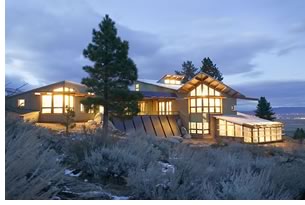

11/2005
 by
Russell Boniface
by
Russell Boniface
Is it easy being green? Yes, believes Vivian Loftness, FAIA, chair of the AIA Committee on the Environment (COTE). Green design is beautiful design for Loftness, professor of architecture at Carnegie Mellon University in Pittsburgh. She leads 45 COTE chapters and 7,000 members who advocate the principles of green design, sustainability, and the built environment.
Energy crisis ignites action
“COTE is a longstanding committee that was generated shortly after
the first energy crisis in the late ’70s,” says Loftness. “There
was a point at which architects looked at the consequences of energy inefficiency
and saw the challenges we were facing if we continued on the same trajectory.
We began to think that architects should play a central role because there
wasn’t a good national understanding of what is an environmentally
sound or energy-efficient building. So the early committee began to develop
a definition of green buildings. That definition was rolled into the LEED™ environmental
standards.”
That first committee began to solidify by the ’80s, forming chapters. Many of the early AIA COTE leaders were developers of the first generation of LEED standards.
“In the beginning, that first committee within the AIA catalyzed a national focus on energy and environmentally sound buildings and helped clarify what goals we can set for ourselves,” explains Loftness. “Early COTE members were environmentalists and energy people from every AIA chapter who said, ‘wait a minute, we need to do something about the environment and about energy.’ That committee predated the U.S. Green Building Council. It believed we had to think and act globally and work on behalf of local and state governments to enact change.”
New energy and environmental design standards were created in numerous states. “The architects led changes that really drove better design and construction practices,” notes Loftness. “I think it was probably a fantastic success story of an AIA committee effecting national change. Now we are seeing things being done to impact change in local, regional, and state policy and, in some cases, national policy. COTE’s strength is that it’s a series of very strong chapters, each of which is saying we have to effect change.”
Professional and student development
A goal for Loftness is to enhance the training of architects and university
students in sustainability, green design, energy-efficiency, and high-performance,
environmentally responsive buildings.
“Our role in educating existing professionals has been indirect because there are no national and local standards asking for green buildings and sustainable practices,” says Loftness. “But architects are seeking opportunities for CEUs in that area. Big firms like HOK are setting up educational courses for their employees to be on top of green design and sustainability. We didn’t trigger that. I think it’s an outfall of changing policy. So the inroads are being made in educating our professionals.
“We have the potential to be leaders in the energy and environment equation on a national scale. The first step is to improve gas mileage in cars, but that won’t engage the architecture profession in the solution. If Congress and the executive branch are saying it’s time for us to be actively looking at innovation for energy efficiency, we have to look at ways we can use natural resources. For example, more windows to serve as a heating, cooling, and ventilation source instead of sealed facades. It could make for more dynamic and exciting architecture and could be regional, such as being specific to desert architecture for a hot, dry climate.”
 But Loftness feels the shift has been much slower at the university
level. “Demands have come from the students, who are saying ‘we
really want more sustainability courses.’ Faculties do have at
least one or two mandatory design courses in their curriculum for that,
but that’s a far cry from having a whole mindset about the environment.
So there has been a pull from the students who have gotten deans to say, ‘Let
me add a studio or another course or some electives.’ The real
questions are: Where can the research happen? Where can we test technology?
Where can we look at performance indices? Where can we look at the impact
of better buildings on human health and performance? Industry doesn’t
have large research units looking at these questions. Universities would
like to host those research groups, but the question is where can the
resources come from to build those laboratories.”
But Loftness feels the shift has been much slower at the university
level. “Demands have come from the students, who are saying ‘we
really want more sustainability courses.’ Faculties do have at
least one or two mandatory design courses in their curriculum for that,
but that’s a far cry from having a whole mindset about the environment.
So there has been a pull from the students who have gotten deans to say, ‘Let
me add a studio or another course or some electives.’ The real
questions are: Where can the research happen? Where can we test technology?
Where can we look at performance indices? Where can we look at the impact
of better buildings on human health and performance? Industry doesn’t
have large research units looking at these questions. Universities would
like to host those research groups, but the question is where can the
resources come from to build those laboratories.”
Part of the problem, she believes, is that groups such as the National Science Foundation and the National Institutes of Health will not fund research labs for architecture.
“Universities go to the NSF or the NIH to ask for funds for labs. And although there is a continuous stream of federal funding that goes to universities for labs for chemistry, optical technology, and nanotechnology, if you went to the NSF or the NIH and asked for funds for building-research labs, the answer would be no. NSF would say ‘we do fundamental, not applied research.’ NIH would say ‘we don’t look at triggers, we look at cures.’ It means there are few PhD and master of science degrees with intensive lab learning in architecture, and very few architecture students who go on to advanced studies. So we’re not feeding knowledge into better building technologies because there is no sustained funding for these graduate programs. As a result, we’re not sending architects into leadership positions in government and industry.”
With funding from the Tides Foundation, COTE awarded $3,000 to three schools of architecture for the most cutting-edge sustainability courses. Loftness hopes to continue to increase awareness of the importance of research facilities for schools of architecture. “We will promote the notion that energy and environmental conditions are a major player in the health and performance of citizens, and that we ultimately should be investing in research to demonstrate that.”
Reaching out to the GSA
Loftness and COTE were involved in supporting the passage of a provision
by Congress of a bill authorizing $50 million for 2006-2010 for the
General Services Administration (GSA) to create a photovoltaic energy
commercialization program. The GSA would purchase and install solar
electric systems in new and existing federal buildings, increasing
the manufacture of the photovoltaic hardware to lower costs for private-sector
installations.
The AIA Government Advocacy team lobbied members of Congress for the provision and rallied AIA members to send e-mails to their representatives to support funding this project as the House of Representatives began to debate the Energy Bill. When the House passed its version of the bill on April 15, the provision was included. Loftness thinks it’s important to connect with the GSA.
“The GSA, due to their commitment to high-quality, sustainable buildings and energy-environmental factors, is the most important of anyone we can try to reach,” she states. “They have built a research group, a sustainability group, and a group dedicated to quality buildings. It’s critical for the federal landlord to put into the forefront issues of sustainability, energy, and the effective use of land and transportation. It’s very important for the AIA to support what the GSA is trying to achieve.”
 Sustainability equals cherishability—The
Green Project Awards
Sustainability equals cherishability—The
Green Project Awards
The AIA/COTE Green Project Awards gives Loftness and COTE members an
opportunity to help refine what makes a sustainable building.
Each year, COTE invites electronic submissions of built projects for its AIA/COTE Green Project Awards. The U.S. Environmental Protection Agency’s ENERGY STAR® program is a sponsor. The selected projects are best-practice examples of a high-performance, sustainable design approach. The criteria for judging is the 10 measures and supporting metrics: land use, site ecology, community design and connection, water use, energy performance, energy security, materials and construction, light and air, bioclimactic design, and long life/loose fit. Each year COTE receives 40-70 submissions.
Loftness enjoys having the chance to be involved in the jury process for the Green Projects Awards. “I’ve served on a lot of juries, and, to me, it’s the best jury material I’ve ever had to judge for a project because it gives you much more depth about not only how beautiful the building is, but also what its unique features, process, and intent are.”
The qualitative values of green design are something the jurors look for in a submission. “Many of the energy standards tend to evaluate green on a quantitative basis. COTE wants to champion the most exciting innovations in architecture and also champion the qualitative values of green design. While green principles can be breathtaking on the outside, they can also be something you don’t see that is on the inside.”
Loftness says that the award can help bring recognition to the importance of sustainability. “Sustainability means that the building will evolve over time. A building that doesn’t have a long life will become the subject for demolition, which is totally non-sustainable. I think that real sustainability means cherishability—a building will be appreciated for an award for a long time to come.”
A Green Award winner can be both good engineering and fabulous architecture, according to Loftness. “COTE members feel that the best green design is also great architecture, and that we want to make sure those images are put in front of AIA community members so that they aspire to be green designers.”
There’s no ‘i’ in ‘green’
Sustainability, green design, environmentally responsiveness, and energy
efficiency are all part of a collaborative effort, maintains Loftness. “The
notion that one brilliant mind is going to make the next generation
of buildings is no longer valid and raises the questions: How well
are we working with allied organizations and fields? How can our own
educational process engage us with our peer professionals so that we
are all leaders of a collaborative team? Excellence in design is built
on a solid foundation of integrated experience, and we want to bring
that to the process but also want to be able to manage the process
as a collaborative one.
“COTE is a collaborative AIA knowledge community, and it’s the combined expertise of all the chapters that makes us move forward.”
Copyright 2005 The American Institute of Architects.
All rights reserved. Home Page ![]()
![]()
